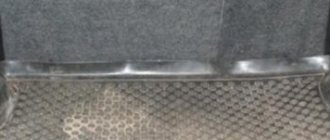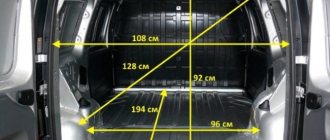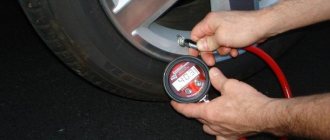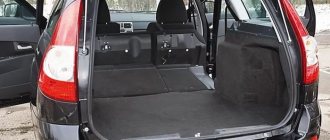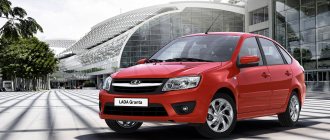VAZ-2104 is the second station wagon belonging to the classic Zhiguli family. An unpretentious, and most importantly, quite roomy car, it appealed to many Soviet car enthusiasts, especially those who, for one reason or another, often had to transport bulky cargo. However, in the USSR they often did not pay attention to the body type - the main thing was to purchase the coveted car. However, even taking into account this circumstance, the “four” should still be distinguished among all products of the Soviet automobile industry.
We are drivers
Let’s not lie - the “classic” is not a competitor to the “ten” in terms of handling, even to the station wagon. But even with the archaic suspension of the Zhiguli, it is possible to achieve acceptable behavior of the car on the road, if everything in it is functional and properly configured.
When two cars drive behind each other in the same mode, you notice the first strange thing in the behavior of the “four” – the setting of its shock absorbers. Contrary to modern ideas about controllability, they begin to work only when the wheels move quickly. No - they react to hitting potholes or strong body rolls in turns, but the subtle movements of the steering wheel, which the driver usually uses to keep the car on a given path, are almost completely ignored.
Undoubtedly, the lack of a clear response to subtle control inputs is a problem not only with shock absorbers. Play in the steering, even small, contributes. It can also be treated by timely adjustment of the steering mechanism and installation of a less pliable pendulum lever. These are sold in stores and are even in demand, but, as far as we know, they do not end up on the production line.
Let's not forget the silent blocks - the performance of the suspension directly depends on their condition and quality. Try asking the salesperson at a car dealership which ones are “the best”. An honest person will first answer you that there are no “best” ones, and only then will he begin to recommend something.
Are we getting carried away? Sorry. Please do not judge strictly - I am ready to explain the reason for this lyrical digression. One of our colleagues (a person with extensive experience) was shocked by the controllability of the “four” that came to us for testing. Since he had his own “classic”, it turns out that a lot has changed in these cars. And not for the better. What is the “eleventh”?
It’s annoying in a new car, especially not the cheapest one, to hear crickets in the right door and the constant creaking of the rear parcel shelf. The adjustment range of the right mirror was too small or too biased towards the driver. In the extreme “far” position, the starboard side is clearly visible in the mirror, and in order to assess whether it is possible to change lanes to the right, you have to lean your whole body.
The design features of the car are such that its response to turning the steering wheel depends too much on the speed of the maneuver. A small amplitude, but fast movement of the steering wheel when going around an obstacle here reaches the wheels with a great delay or does not reach it at all - as if it is stuck somewhere.
In general, the “eleventh” is more strict and precise in control, less lax and not so “independent”. Landing in it is much more comfortable. However, let's say a kind word about the Quartet. For example, on a bad road you don’t feel so sorry for it – against the general noise background, the suspension doesn’t seem to “thump” much. And also, with the kind of mirrors that the dealer installed on our car, visibility became simply excellent (when will the factory bother about this?).
However, it's time to move on to the next comparison indicator.
Which one do we take?
Of course, the “eleventh” is a cut above, but, realizing that the VAZ-2104 took part in an obviously unequal battle, I will allow myself a few “IFs”.
If, when using a VAZ-2111 as a delivery vehicle, you have to slam the back door ten times a day to close it, someday it will completely bore you.
If, during the same official use, you load anything into the velor-covered trunk of the “eleventh”, you will be tormented with dry cleaning.
If a private owner, who is ready to load the “barn” to the roof with potatoes and tomatoes, sometimes hits the curbs with his sagging backside, he will ruin himself by repairing the “tenth” bumper.
And one more, final “IF”. If the car manufacturer intends to continue to think about the consumer as unflatteringly as the consumer thinks about him, and just like the consumer, to live in hope of a model from a bright future, he will get to this very future alone. Without a consumer.
Author: Alexander Budkin
There is a long-awaited addition to the small regiment of domestic station wagons - IZH-Fabula has entered service, standing shoulder to shoulder with the VAZ 2104. It is not difficult to guess that the new product is designed to become more attractive than the long-familiar one. Behind the wheel
Like God a turtle
Assembling cars can truly work wonders - both literally and figuratively. In direct terms, this is when, communicating, for example, with a simple Matiz, you cannot understand why you like it. Miracles in a figurative sense - on the contrary, when, having driven a modern domestic car, which has a good maximum speed, low fuel consumption, and the climate is controlled by an SAUO computer, you still want to call it Soviet.
And yet the greatest miracles await in a car built to be cheap. You lift the trunk floor covering and stains of rust are visible on the fresh paint that still smells like a conveyor belt. You open the driver's door and see a deep mark on the center pillar that some screw at the end of the door has torn through the metal. When you hang the car on a lift, you immediately see what’s in it. There are drops of antifreeze on the stabilizer mount, and oil drops on the clutch housing. Here is a black spot on the resonator tube - this is the “cut” of the exhaust. Here the muffler bracket hits the body.
The reader decided that we clearly sympathize with the VAZ-2111 - it didn’t happen at all! The copy we received had great difficulty in engaging first gear, and reluctantly in second and third. One of the possible reasons is carelessly assembled rods between the gearbox and the gearshift lever. At least, an inspection in the pit showed that their connecting clamps were bent, and the reaction rod was generally hanging out in the front bracket.
It turns out that the more you learn about cars, the less you want to answer the question...
Vehicle interior
There is no design approach, no dry design of functional details. The goal of the manufacturers was to make a working car “without worrying” about comfort and appearance. The minimum number of required devices confirms this in practice.
The interior has fabric upholstery with faux leather headrests. Rear row - the sofa folds to expand the luggage space.
If we consider the equipment, we can highlight such tidy elements as a volt-ohm meter, an econometer, a battery charge, and a low oil pressure sensor. As well as the standard tachometer, speedometer, odometer, lamp unit and parking brake.
On the central panel you can find a seat belt sensor and heated rear window, which is very good for such an unequipped car. And as standard there is a clock, a brake warning lamp and a fuel level indicator.
There are also additional keys for turning on fog lights and switching operating modes of the stove. You have the opportunity to install the radio in an existing niche.
The “four” has a glove compartment with a lock, visors with pockets, a sound signal in the classic place, and a cigarette lighter. As well as steering column switches for turning on the wipers and turn signals.
Separately, it is worth noting the trunk, although the rear seats fold down, they do not do so completely, so it will still not be possible to transport a long load. For this kind of purpose, the 2104 has roof rails, but the weight of the cargo should be limited, because This model has worse roof rigidity than other body types. In general, it is worth remembering the low possible load, which should not exceed 450 kg, taking into account the weight of cargo and passengers, otherwise the chassis may become faulty.
A little history
The production of this model was started by the Volzhsky Automobile Plant in 1984. Practice has shown that the designers managed to create a fairly good car with a decent amount of luggage compartment. This is evidenced, in particular, by the fact that the “fours” rolled off the assembly line until 2012. After the collapse of the USSR, VAZ was assembled in:
- Russia - VAZ (Tolyatti), RosLada (Syzran), IzhAvto (Izhevsk);
- Ukraine – KrASZ (Kremenchug), LuAZ (Lutsk), AntoRus (Kherson);
- Egypt – Suzuki Egypt.
In April 1985, the “four” completely ousted the first VAZ station wagon, 2102, from the assembly line.
At the same time, it received several original rear parts from its predecessor.
The “four” is based on the VAZ-2105 with a sedan body. In those days, one of the main tasks of the designer when creating a new model was the need to combine maximum consumer effect with minimal production costs. Comfort is a relative concept here. For example, a windshield wiper and electric rear window heating appeared on stock VAZ-2104 only in 1994. In addition, in order to attract new buyers, later modifications of the four were equipped with a 5-speed gearbox. Changes also affected the interior of the car - in particular, the VAZ-2104 began to install anatomical front seats from the “Seven”, which was considered a more prestigious car than the “Five”.
Particular attention should be paid to the diesel modification of the Quartet. Its production began in 1999, in Togliatti. A domestically produced 1.52-liter diesel engine was installed on the car. This power unit was produced by the Barnaultransmash enterprise. However, the purchase of a diesel “four” was inappropriate from an economic point of view. The cost of this modification was higher compared to gasoline analogues with lower power. Accordingly, the diesel “four” never became widespread - the car was produced in small batches, and in 2004 they decided to completely stop the experiment, curtailing production.
Specifications
A car in a station wagon weighs a little, only 1020 kg (for comparison: the “five” and “six” in a sedan body weigh more - from 1025 kg). The dimensions of the VAZ 2104, regardless of the configuration, are always the same:
- length - 4115 mm;
- width - 1620 mm;
- height - 1443 mm.
Thanks to the folding rear row, the trunk volume can be increased from 375 to 1340 liters, which made it possible to use the car for private transportation, country work and even small businesses. However, the back of the rear sofa does not fold entirely (due to the specific design of the car), so it is impossible to transport long cargo.
However, long elements are easy to fix on the roof of the car, since the length of the VAZ 2104 allows you to transport beams, skis, boards and other long items without the risk of creating dangerous road situations. But you cannot overload the roof of the car, since the calculated rigidity of the station wagon body is much lower than that of sedans of the next generations of VAZ.
The total load on the vehicle (passengers + cargo) should not exceed 455 kg, otherwise damage to the chassis may occur.
The “Four” was equipped with two types of drives:
- FR (rear-wheel drive) is the basic equipment of the VAZ 2104. Allows you to make the car more powerful.
- FF (front-wheel drive) - selected models were equipped with front-wheel drive, as it is considered safer; subsequent versions of the VAZ began to be produced only in front-wheel drive.
Like other Lada representatives, the Four has a ground clearance of 170 mm. Even today, this is a completely reasonable ground clearance, allowing you to overcome major road obstacles.
Engine characteristics
Over the years, the VAZ 2104 was equipped with power units of different power: from 53 to 74 horsepower (1.3, 1.5, 1.6 and 1.8 liters). Two modifications (21048D and 21045D) used diesel fuel, but all other versions of the “four” consumed AI-92 gasoline.
Depending on the engine power, fuel consumption also varies.
One of the undoubted advantages of the VAZ-2104 was its decent trunk volume.
One of the main parameters for station wagon cars is their spaciousness and carrying capacity. The Quartet is no exception to the general rules here. Many car enthusiasts were ready to accept minimal comfort and, in fact, Spartan conditions, just to be able to transport as much cargo as possible.
Let's look at specific numbers. All modifications of the Quartet have a luggage compartment volume of 375 liters. However, everyone probably knows that this figure can be increased by folding the rear seats. A few simple movements, and the luggage compartment volume is already 1,340 liters. In other words, you can place some bulky cargo there without any problems. At the same time, the back of the rear seat, unlike foreign cars, folds completely. This is not always very convenient, but VAZ engineers considered this option more feasible from an economic point of view. It turns out that the convenience of car owners was sacrificed for lower production costs - an approach quite typical for the Soviet automobile industry.
Delivery of goods to the population
The fifth door of the “ten” is probably its most unfortunate place. On our sample, it closed only after three to five strong claps, and sometimes it opened only after the second press of the remote trunk release button. Do you think it can be adjusted and used for health? Does not work. From the experience of using other VAZ-2111s, we know that adjusting the fifth door lock can alleviate the suffering of this body part (and the owner of the car), but not eliminate it.
And also, I’ll tell you a secret, the author did not have enough strength to recline the right (smaller) part of the rear seat back in the same “eleventh”. A stronger (about 130 kilograms) comrade helped. So that I wouldn’t get upset, he explained that the point was that I didn’t have a solid skill. They say, I don’t know in which direction it needs to be rocked, but he knows. True, he still agreed that cars couldn’t be made that way.
In the “four”, everything is in order with the fifth door, and the seat folds easily. Just to fold the backrest alone, you will have to walk twice from its right latch to the left. If we take for granted the continuous backrest of the rear seat, the VAZ-2104 still wins as a truck. But it’s worth picking up a tape measure.
The distance from the trunk floor to the shelf in the “eleventh” is 50 cm, in the “four” – only 40. From the fifth door to the folded seat, respectively, 160 and 145 cm. The maximum size of the luggage compartment diagonally on the floor is 200 and 180. In general, no matter where you place the tape measure, you will find more in the station wagon of the “tenth” family. We even decided to determine the maximum size of the cabin diagonally and from bottom to top, as if we were going to drive a lining. And here 2111 has an advantage - 280 cm versus 270.
Skoda Kodiaq
Good afternoon! I am writing my personal opinion about the Skoda Kodiaq, on which I have already driven more than 27 thousand km. So.
Dealer news:
New cars and used cars - tens of thousands of ads for sale. Reviews from car owners. Technical characteristics and accessories. Comparison of models and Test Drives. News from the world of cars. Prices for new cars. Promotions and special offers from car dealerships. We will help you make your choice!
This site is for informational and reference purposes only and under no circumstances constitutes a public offer.
Certificate of registration of mass media EL No. FS77-68106 dated December 21, 2016. Issued by the Federal Service for Supervision of Communications, Information Technologies and Mass Communications. 16+
Owner reviews
- Vitaly, Smolensk. In 2014, I managed to snatch a VAZ-2104 in excellent condition. The car is from 2005, with a mileage of 60 thousand km. Bought for 3800 USD. e. A completely normal device for transporting everything that can be transported - fruits, vegetables, furniture, equipment, etc. I work as a courier, I am my own boss. As for the suspension, the settings of the VAZ-2104 chassis are more suitable for bad roads - broken asphalt, country roads, hillocks, etc. On light off-road conditions, the VAZ-2104 turns into a crossover, albeit with rear-wheel drive. The fact is that in such conditions there is no need to accelerate, since at a decent speed (for example, in a city or on a country road) the car rolls and sways a lot. This is all due to the soft suspension and high ground clearance of 170 mm. I change consumables on time, as well as other parts and spare parts. The engine is high-torque, but very noisy. Consumes up to 10 liters in the urban cycle.
- Anton, Budennovsk. I recently sold my VAZ-2104, which has served me faithfully for six years. The car was purchased new in 2012, with a warranty. Clean and well-groomed - that’s how I sold it for good money. Nothing creaks or rattles. I took good care of the car - regularly changing pads and consumables. Average fuel consumption is 8 liters in the city, on the highway it is 6 liters per 100 km. The main advantage of the station wagon is its load capacity and energy-intensive suspension. I will also note the high ground clearance of 170 mm. The car behaves adequately at speeds of up to 80 km/h, and then you have to steer - there is lateral rocking, and the car scours the highway. But in the city the speed is no more than 80 km/h, and the ride is quite comfortable.
- Vadim, St. Petersburg. I use my father’s car from 2001, with a 70-horsepower 1.5-liter engine. The car sat in the garage for a long time. I rolled it out only in 2022. I had to replace something in the chassis, change consumables, etc. Then the car drove like clockwork. For the city, the option is just what you need - it wouldn’t even be a shame to break it up. I drive quietly and leisurely, trying not to violate traffic rules. Such a station wagon is also suitable for work - for example, for transporting food. There is a lot of space inside, especially if you fold down the rear seats. You can drive along country roads and rough terrain without any problems. To increase stability, I installed the rear discs with offset to the outside. But due to the ground clearance of 170 mm, the car still rolls. The suspension travel is large, but during a quiet ride it is not noticeable.
Design features [edit | edit code]
Since the front part of the car is identical to models with a sedan body, it is more difficult for a standard heater to warm a larger volume of the interior during the cold season. The back of the car often fogs up in cold weather. The car normally does not have rear ventilation holes for venting interior air (unlike the VAZ-2107), which makes it difficult to close the doors (with the windows closed). Compared to the VAZ-2105, 2107 (with identical engine installations), it has a lower maximum speed (data from the “operating instructions”
142 km/h) due to the changed final drive ratio - 4.44 (early modifications) versus 4.3 on the sedan. The rear door is subject to contamination by road dirt (dust raised by wheels), which is locally drawn when driving at high speeds into the low-pressure zone - this is corrected by installing an upper deflector on the 5th door, supplying (to the low-pressure zone) cleaner air from the roof. There is also a way to avoid the accumulation of dirt on the back door - this is to change the design of the rear bumper - the lower part must be bent in the opposite direction and the gap between the bumper and the body must be closed - a plate 1 meter by 15 cm in the middle. The gas tank with a volume of 43 liters (versus 39) is located horizontally under the bottom of the trunk without additional protection - there is a risk of damage when driving over rough terrain.
Engine
| Engine capacity | 1450 cm3 |
| Power | 75 hp |
| At rpm | 5600 |
| Torque | 104/3400 n*m |
| Gas distribution mechanism | OHC |
| Number of cylinders | 4 |
| Number of valves per cylinder | 2 |
| Cylinder diameter | 76 mm |
| Piston stroke | 80 mm |
| Compression ratio | 8.5 |
Load capacity and capacity of VAZ station wagons and hatchbacks
28.01.2000
Those who especially value a truck in a passenger car prefer station wagons, or, in extreme cases, hatchbacks.
VAZ-2104
- the most common and cheapest station wagon. The “Four” does not amaze with the high-pile carpets in the trunk (there are none there at all) and the exquisite door upholstery. But the plastic is easy to clean, it is not afraid of spilled Antifreeze and Obzor. Like a truck, the car is spoiled by the awkward trunk shelf, the fifth door opening tapering towards the bottom, and the wheel arches. You can easily transform the interior.
VAZ-2111
— the last word in the field of domestic universal construction. The successor to the Quartet holds 25% more in volume and 10% more in weight. In terms of carrying capacity, the “eleventh” was even ahead of the spring-loaded “Volga”. The rear seat, like on decent foreign cars, easily folds out in parts (2:1), creating the only problem - where to put the headrests? In general, the “eleventh” is a modern, surprisingly roomy “shed”. In terms of product and price: a front-wheel drive station wagon is twice (!) more expensive than a “classic” one.
If the “barn” is not to your liking, but you need to carry something more than a “diplomat”, they choose a compromise - a hatchback.
VAZ-2109
— at the beginning of production it was perceived as a prestigious, not a “business” car. Nowadays, when purchasing a Samara, its cargo qualities are increasingly taken into account. When the rear seat is folded down, the luggage compartment is quite spacious, but difficult to load. A natural disadvantage of all hatchbacks: the rear side and the fifth door get in the way. The volume of the cargo compartment is eaten up by the sloping rear wall - with comparable internal dimensions, the “nine” holds 50 liters less than the “four”. The three-door VAZ-2108 will cause even more inconvenience - it can only be loaded through the rear door, while the 2109 allows you to use a pair of side doors. “Nine” is the most modest hatchback in terms of cubic capacity. In this car, the passenger element still dominates. Cargo capabilities are more of an add-on to other qualities.
Characteristics of VAZ station wagons and hatchbacks
| in standard version | 270 | 380 | 255 |
| when loaded to the ceiling | 470 | 575 | 355 |
| With the rear seat folded | 970 | 1215 | 920 |
| Dimensions, mm | |||
| A – total length of the luggage compartment | 1600 | 1630 | 1380 |
| B – distance to the rear seat | 1000 | 1030 | 820 |
| B – width of the compartment between the wheel arches | 910 | 930 | 930 |
| G – height | 800 | 930 | 850 |
| D – tailgate height in hatchbacks | 0 | 0 | 320 |
| E – rear door opening height | 730 | 890 | 490 |
| Weight, kg: | |||
| Curb Cargo transported | 1020 455 | 1030 500 | 945 425 |
Based on materials from the magazine “Behind the Wheel” No. 1, January 2000.
"" Back
( 2 ratings, average 4.5 out of 5 )
General parameters of the VAZ 2107
Length – 4145 mm Width – 1620 mm Height – 1446 mm Base – 2424 mm Front wheel track – 1365 mm Rear wheel track – 1321 mm Ground clearance – to the front suspension cross member – 159 mm, to the rear axle beam – 154, to muffler housing – 120 mm. Not bad, for example in the Opel Zafira, only 150 mm to the highest point. Load capacity – 400 kg Trunk volume – 385 liters Curb weight – 1060 kg Gross weight – 1460 kg Weight of towed trailer, without brakes – 300 kg, with brakes – 600 kg.
VAZ 2107 body
All-metal, load-bearing, with 4 doors. Body rigidity – 7200 Nm/deg.
The width of the VAZ 2107 interior , and all classics in general (from the rear door trims at the seat level) is 1250 mm. Between the central pillars of the cabin, at a level of 80 cm from the floor - 1234 mm.
The length of the front door opening of the VAZ 2107 (and all classics) is 889 mm, the rear door is 819 mm.
Dimensions of the trunk of the VAZ 2107:
Electrical equipment VAZ 2107
Wiring type: single-wire, negative on the car body (ground).
Battery: 6ST-55, capacity 55 Ah. Batteries with a capacity of 60 and 65 Amperes are also suitable, but you need to check the dimensions. Typically it is 242mm x 175mm x 192mm.
Operating voltage in the network: 13.6 -14.6 volts. The generator (G221) must deliver a current of no more than 1/10 of the battery capacity, i.e. approximately 2 to 5.5 Amps.
Ignition coil – B117 or B117-A (for carburetor engines) Starter – ST221
Lamp type:
– lamp for low and high beam: H4 or AKP2-60+55 (in Russian) – lamp for side markers and side turn signals: T4W or A12-4-1 – lamp for turn signals in the headlight, fog lights, reverse and brake lights: P21W or A12-21-3 – license plate and interior lighting lamp: C5W or AC12-5-1
